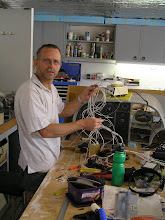Call in another favour from my mate Gordon who has a flash lathe (mine is a lightweight toy). I got Gordon to build me a similar plug to the first this time out of MDF. The shape and finish of this one was almost perfect, good enough for a non commercial build.
What you see below is the plug with a couple of coats of clear polyurethane varnish. Once this hardened I sanded the fur of and applied several additional coats, sanding between each.

Several coats of varnish later she is looking great. the tip was a bit off so I slapped a little epoxy/micro on it and sanded to shape.

Waxed several times and painted with release agent it is ready to attack with gel-coat and polyester.
Eeeek green goo. I thought tooling gel was orange. Oh well as long as it works. Big flange to allow me to vacuum bag the spinner later on. I received mixed advice about whether to make this a split mould or not. As you can see I went with the "not" option as there were no negative curves to stop the cast part from coming out. Later I will tell you how this was almost a failure for me.

Let the gel-coat set up till just tacky then start laying up the first layer of glass to stabilize the gel. I'm using CSM and polyester resin for this. Cheap and easy to use.
Once the entire surface has been covered take to it with a roller to work out any trapped air and to incorporate the resin and glass matrix.

Let the gel-coat set up till just tacky then start laying up the first layer of glass to stabilize the gel. I'm using CSM and polyester resin for this. Cheap and easy to use.

Once the entire surface has been covered take to it with a roller to work out any trapped air and to incorporate the resin and glass matrix.
Let the first layer set, knock the surface down with rough abrasive and then add several layers more. This is the finished mould.
Add strips of ply to stop it from rolling around when laying in the final part. I set these in a bed of flox and polyester.

Add a few scraps of glass to ensure nothing moves and let it set.

Now this is where the decision not to do a split mould came back to bite me. You see I had built an extremely strong mould (as you should) and the MDF plug was equally robust. There was going to be no way on earth either was going to move even the slightest amount so I could work them apart. After much huffing and puffing and head scratching I decided the only way out was to cut my lovely plug out of the mould. Carefully hacking at the soft MDF it only took a few hours to remove all the plug and the result looks like this. Yes that is a scratch ... damn it. It'll polish out.

Add a few scraps of glass to ensure nothing moves and let it set.

Now this is where the decision not to do a split mould came back to bite me. You see I had built an extremely strong mould (as you should) and the MDF plug was equally robust. There was going to be no way on earth either was going to move even the slightest amount so I could work them apart. After much huffing and puffing and head scratching I decided the only way out was to cut my lovely plug out of the mould. Carefully hacking at the soft MDF it only took a few hours to remove all the plug and the result looks like this. Yes that is a scratch ... damn it. It'll polish out.







No comments:
Post a Comment